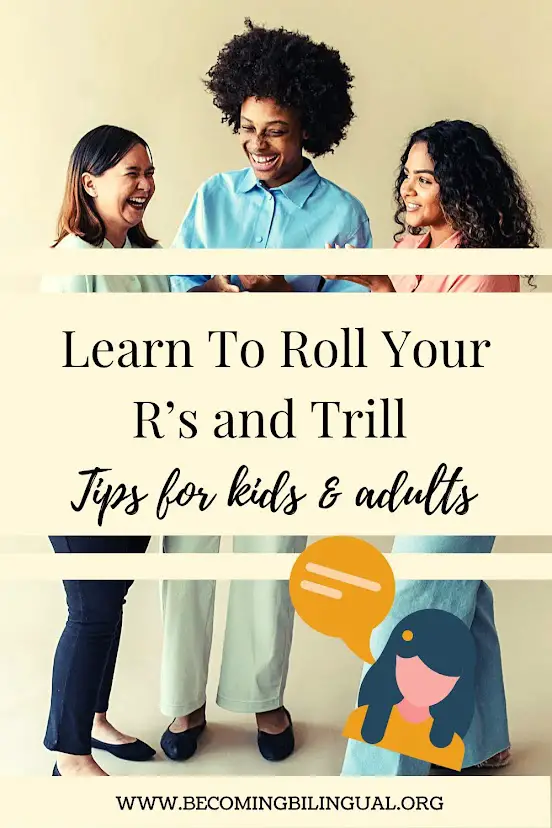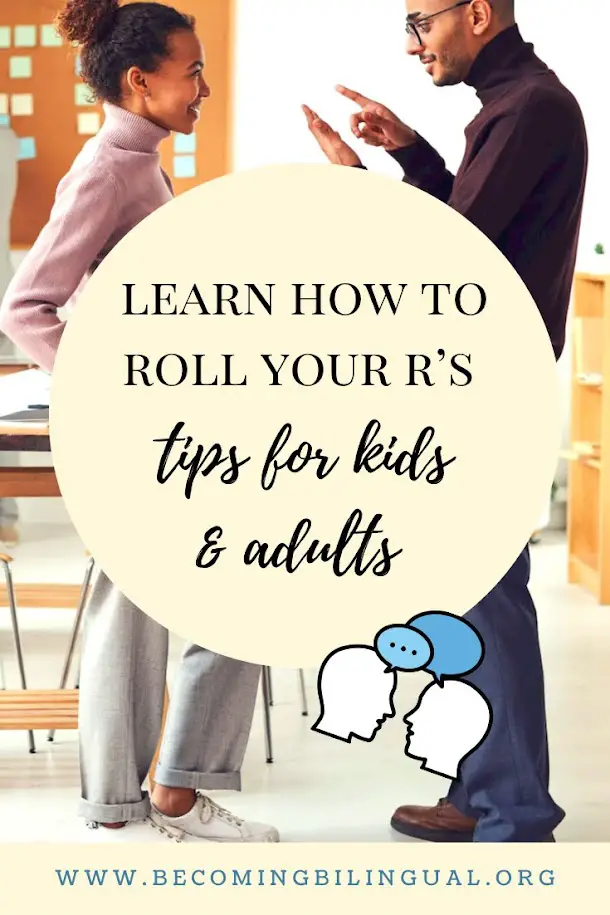A Step by Step Guide On How To Teach Your Child To Roll Their R’s

Last Updated on February 18, 2023 by Reina Victoria
When my daughter was 3 I remember being so worried that she would never be able to roll her r’s. I had no idea how to teach her to do that and we didn’t have many opportunities for in-person practice with native speakers because we were entering a global pandemic!
I didn’t really have anyone to talk to about rolling r’s since several of my family members can’t roll theirs and none of them speak Spanish…
While you don’t need to be able to roll your r’s to communicate and speak in Spanish, it was something that I was hoping I could help my daughter with.
I wanted to make sure that she had good Spanish pronunciation and that her Spanish communication skills were strong.
Read more helpful tips about bilingual parenting here: Bilingual Parenting: Spanish for the Family
Table of Contents
What is the rolling r?
Spanish is not the only language that uses a ‘rolled r’, it’s actually common in many languages around the world. In Spanish, it’s often called the “trill” or the “alveolar trill”
The trill is a sound that is made by pushing air past your tongue so that it vibrates.
Anyone can make the trill sound – regardless of what language they grew up speaking. You just need to understand and practice the skill!
Even in Spanish speaking countries, it’s common for children to need practice to make the trill sound and it’s often a skill that develops later than other sounds.
When I was worried about my daughter’s ability to produce the rill, I spoke with a Kindergarten teacher from Puerto Rico who gave me a few tips on helping children and adults to roll their r’s. She said that she would teach the trill sounds regularly to her students, since it was still typical for them to be learning to produce that sounds at age 5/6.
The following guide is based on her advice but also from some of my own research and experience with teaching my daughter.
How to roll your r’s
Step 1:
If your child is old enough to have control over their mouth muscles and can follow directions, you can talk them through how to make the <r> sound.
When we make the regular /r/ sound we’re putting the tip of our tongues on the bumpy area on the roof of our mouth that’s behind our front teeth (alveolar ridge). Having good formation can help them to start to roll their r’s when they try.

Step 2:
Practice saying words and phrases that have the <r> sound. This works great if your child is a little older or likes the idea of a challenge.
Listening to audio recordings and trying to repeat tongue twisters and phrases that have multiple words with the <r> sound can be a fun way to get more practice in. When you repeatedly listen to a song and start to sing the lyrics by yourself, you can get more of that practice in. I started with some great Spanish music with my daughter to help her hear more fluent and natural Spanish!
Recommended for you: Top Spanish Songs That Are Trending Right Now
Here are a few tongue twisters (trabalenguas en espanol!) that we would say. They were super hard for me as a non-native speaker so it was good practice 😊
This trabalenguas is good for practicing the short /r/ sound. If you or your child needs support with working on the /r/ sound in regular words, this can be a good starting point. Once you have good /r/ pronunciation you can start to work on the <r> sound.
La rana y el ratón
Juegan a la ruleta,
Y cuando tienen hambre
Preparan la recta
These trabalenguas are short and sweet and better for practicing the <r> sound. If you’re already good at pronouncing the /r/ sound, then jump right to these!
Erre con erre, guitarra
Erre con erre, carril:
Rapido rueden los carros,
Rapido el ferrocarril.
El perrito de Rita me irritia,
Dile a Rita
que cambie el perrito
por una perrita
Step 3:
I know how to roll my r’s so my daughter was always able to hear me pronounce the correct sound. If you and/or your child can’t produce the <r> round, it can be really helpful to hear it in regular speech so you can emulate it better.
If you know native Spanish speakers, it’s a great idea to get some practice in with real life conversations in Spanish. Children can quickly pick up speech patterns by listening to a speaker with correct pronunciation.
In the absence of a native speaker, listening to audio recordings of native speakers can help give your child exposure to the correct pronunciation. Listening to books on tape in Spanish, Spanish podcasts and Spanish videos can help give your child some access to native Spanish speaking.
Step 4 (and the most successful way for our family!):
Make it a game! The more practice that they have making this sound, the faster it will come. Saying words that make the <r> sound can be hard for them to practice if they don’t feel like they’re being successful.
One way that I practiced with my daughter was to use her toy cars and planes. When we were playing in the living room or when she was in the bath, I’d have the planes fly around her making an exaggerated <r> sound as they flew. When we were using her toy cars or trucks I’d make them vroom around on the rug and make the <r> sound instead of a ‘vroom’.
She would often grab at the plane or truck and then try to mimic my sound as she moved it around.
Having her hear and practice the sound in isolation, instead of in the context of a word, took away any of the pressure of it having to do with her speech.
This was the most effective way that I found to help my daughter with the r trill. It was a great and easy way to get repetitive practice in and by the time she was 4 she was able to roll her r’s without an issue.
More Resources
When I was looking for way to explain how to roll your r’s, I found this video really helpful. He explains not only how to roll your r’s, but why it might be hard for you if you’re a native English speaker, and what you can do to help get your tongue in a better position to be successful.
Let me know which ones you liked in the comments!
Happy Learning!
Don’t forget to subscribe here and get my latest posts and resources delivered straight to your inbox!